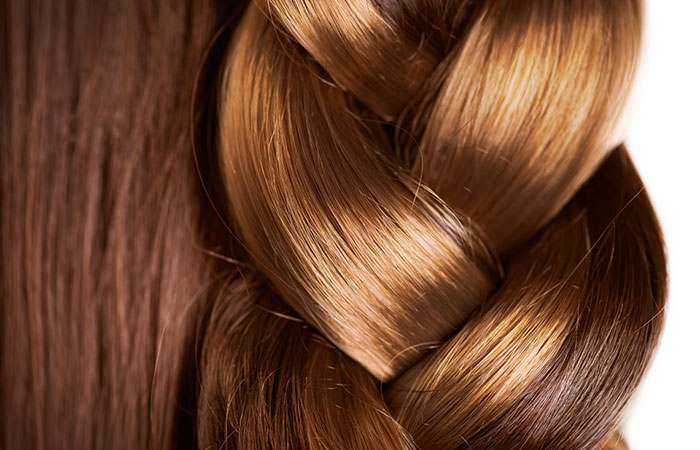
A healthy diet rich in vitamins (A, C, E, B), minerals (iron, zinc) and proteins can contribute to strong and healthy hair. Avoiding heat styling tools, excessive chemical treatments and sun exposure can prevent damage. Regular washing and conditioning with gentle products, regular trimming and scalp massages can also promote hair health.
Regularly washing your hair with a mild shampoo and conditioner, and using a leave-in conditioner or hair oil to keep it moisturized.Regular washing and conditioning to remove dirt and buildup, as well as using leave-in treatments and natural oils to keep hair hydrated, can help maintain healthy hair.
Heat can damage your hair, so try to limit the use of hair dryers, straighteners, and curling irons as much as possible.excessive heat styling can lead to breakage, split ends, and dryness, which can harm the overall health of your hair. It is recommended to use heat protectant products and limit heat styling to once or twice a week.
If you do use heat styling tools, make sure to use a heat protectant spray or serum to help prevent damage.using a heat protectant is important for protecting hair from heat styling tools
Heat protectants work by creating a barrier between the hair and the heat source, reducing the amount of heat absorbed by the hair and reducing the risk of damage such as breakage, split ends, and dryness. Some heat protectants also contain nourishing ingredients that can help improve hair health. It's best to apply heat protectant before styling, and make sure to evenly distribute it throughout the hair.
There are many different types of heat protectants available on the market, including sprays, serums, and creams. When choosing a heat protectant, consider your hair type and specific needs, such as whether you have color-treated hair or if you have dry and damaged hair. Some heat protectants are specifically formulated for certain hair types, so be sure to read the product label carefully to find the best one for you. It's also a good idea to look for heat protectants that contain natural ingredients, such as argan oil or coconut oil, as these can help improve hair health and hydration.
Perms, relaxers, and hair dyes can damage your hair, so try to avoid using them or use them sparingly.
Instead opt for gentler alternatives such as herbal dyes, and regular deep conditioning treatments to keep your hair healthy. Also, consider limiting heat styling tools, like flat irons and curling wands, and protect your hair with heat protectant products.
Ponytails, braids, and other tight hairstyles can pull on your hair and cause damage, so try to avoid them or wear them loosely.
tight hairstyles can lead to hair breakage, thinning, and hair loss over time. Wearing hairstyles loosely or opting for looser hairstyles like buns, soft waves, and loose braids can help reduce the stress on your hair and promote healthy hair growth.
Tight hairstyles can put a lot of tension on your hair roots, leading to traction alopecia, a type of hair loss caused by excessive pulling or tension on the hair. To avoid hair damage, it's important to change up your hairstyle regularly and opt for styles that are less damaging to your hair. When wearing tight hairstyles, it's also important to ensure they're not too tight, and to avoid wearing them for extended periods of time. Additionally, regularly moisturizing your hair and scalp can help keep your hair healthy and reduce the risk of damage.
Getting regular trims can help keep your hair healthy by getting rid of split ends and damaged ends.
getting regular trims can help maintain the health of your hair by removing split ends and preventing further damage. This promotes healthy hair growth and can improve the overall appearance of your hair.
Regular trims can also improve the texture and manageability of your hair, making it easier to style and reduce breakage. It's recommended to get a trim every 6-8 weeks, depending on your hair type and rate of growth. Consistent trims can also prevent hair from becoming too dry and brittle, leading to fewer tangles and knots. In summary, getting regular trims is an important part of a healthy hair care routine.
Additionally, getting regular trims can also help prevent hair from looking dull and lifeless, as removing damaged ends can result in hair appearing shinier and healthier. Regular trims can also make a noticeable difference for those with curly or wavy hair, as removing split ends can help reduce frizz and promote defined curls. Furthermore, having a consistent trimming schedule can help you achieve and maintain your desired hair length, as damaged ends can slow down hair growth. Regular trims can also ensure that your hair stays in good condition, making it easier to style and prevent damage from heat styling tools.
Eating a diet that is rich in vitamins and minerals can help your hair grow strong and healthy. Make sure to eat plenty of fruits, vegetables, and lean protein.
A balanced diet that includes nutrients like vitamins A, C, E, and B vitamins, as well as iron, zinc, and biotin, can benefit hair health. Avoid processed foods and limit alcohol and caffeine intake, as they can lead to hair thinning and breakage.
Additionally, foods high in omega-3 fatty acids like salmon, flaxseed, and walnuts can improve scalp health and prevent hair loss. Hydrating foods like coconut water, leafy greens, and watermelon can also keep hair hydrated and prevent breakage. Drinking plenty of water is also important for hair health.
Established in 2013, FamilyNeeds.net is connected to your lifestyle and everyday life. Publish reviews of your life, style, fashion and essentials.